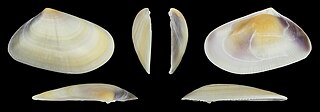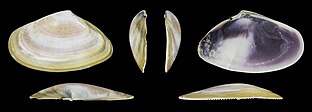Donax trunculus
The coquina (Donax trunculus) is a headless bivalve mollusk of the family Donacidae.
They are small mollusks, measuring 2-4 cm on average, and the largest are 5 cm. The shell is oval and cuneiform, with a fine and soft touch and the color varies between yellowish white to purple. It is also called truncated coquina to differentiate it from other species of Donax such as the xarleta coquina (Donax vittatus). The tellina or tellerina is similar and it is normal to confuse it with the coquina, but they are different species.
Traditionally they can be dug up with the same foot, although today there are special dragging instruments to capture several coquinas at a time. It is done when the tide goes out. This job is called coquinero. In Spain they are captured in Galicia, Valencia and western Andalusia, Costa de Huelva and Cádiz, where they are also consumed the most.
Playback
It is a unisexual mollusk with external fertilization, expelling its eggs into the water. When these hatch, larvae are born that remain suspended in the water (plankton) until they develop the shell and settle on the seabed.
Distribution
It spreads through the mud of marshes, river mouths, and coasts of Europe, both in the North Atlantic and in the Mediterranean, buried shallowly in the sand near the coast, up to about 15-20 centimeters deep. (infratidal level).
Gastronomy
Due to their fine and tasty flavor, in the Iberian Peninsula and in Italy coquinas are considered a delicacy. Its gastronomic use is equivalent to that of the clam (you can make, for example, coquinas a la marinera, derived from the Galician dish of clams a la marinera), and can be served raw, sautéed, in soups, with rice.
On the island of Sardinia there is a typical dish called fregula con le Arselle, which consists of a type of local pasta prepared with conquinas.
Due to its delicate flavor, it is recommended not to season it too much. One of the most popular and traditional ways to cook them is with only garlic, parsley and oil. It is then served as an appetizer or starter accompanied by wine.
Contenido relacionado
Erymanthian boar
Rhinocerotidae
Bovidae
Pan paniscus
Beak









